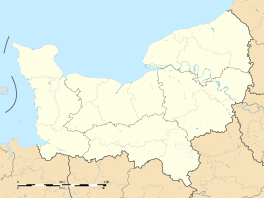Noviomagus Lexoviorum
| Lisieux | ||
|---|---|---|
| Subprefecture and commune | ||

Town hall
|
||
|
||
| Coordinates: 49°09′N 0°14′E / 49.15°N 0.23°ECoordinates: 49°09′N 0°14′E / 49.15°N 0.23°E | ||
| Country | France | |
| Region | Normandy | |
| Department | Calvados | |
| Arrondissement | Lisieux | |
| Canton | Lisieux | |
| Intercommunality | CA Lisieux Normandie | |
| Government | ||
| • Mayor (2008–2014) | Bernard Aubril | |
| Area1 | 13.07 km2 (5.05 sq mi) | |
| Population (2006)2 | 22,109 | |
| • Density | 1,700/km2 (4,400/sq mi) | |
| Demonym(s) | Lexoviens | |
| Time zone | CET (UTC+1) | |
| • Summer (DST) | CEST (UTC+2) | |
| INSEE/Postal code | 14366 /14100 | |
| Elevation | 32–152 m (105–499 ft) | |
|
1 French Land Register data, which excludes lakes, ponds, glaciers > 1 km² (0.386 sq mi or 247 acres) and river estuaries. 2Population without double counting: residents of multiple communes (e.g., students and military personnel) only counted once. |
||
1 French Land Register data, which excludes lakes, ponds, glaciers > 1 km² (0.386 sq mi or 247 acres) and river estuaries.
Lisieux (French pronunciation: [lizjø]) is a commune in the Calvados department in the Normandy region in northwestern France. It is the capital of the Pays d'Auge area, which is characterised by valleys and hedged farmland.
The name of the town derives from the Latin: Noviomagus Lexoviorum ("Noviomagus of the Lexovii"). The town was originally known in Celtic as Novio Magos ("New Field", "New Market"), which was Latinized as Noviomagus. Owing to the large number of similarly-named cities, however, it was necessary to specify where this one was located. The local French demonym Lexoviens derives from the Latin as well.
Lisieux was the capital of the Lexovii. In his work, Commentaries on the Gallic War, Caesar mentions a Gallic oppidum, a term which refers to Celtic towns located on the tops of hills. The oppidum has been pinpointed to a place referred to as le Castellier, located 3 kilometers (1.9 mi) to the southwest of the town. However the Gallo-Roman city was in fact located where Lisieux is to be found today.
Lisieux was an important center of power in medieval times. The bishopric of Lisieux controlled most of the Pays d'Auge by the 12th century. King Henry II and Eleanor of Aquitaine are thought to have married at Lisieux in 1152, and the town remained powerful for several centuries afterwards until in the 14th century the triple scourges of the Plague, war and resulting famine devastated Lisieux and reduced its influence. The main judge of Joan of Arc, Pierre Cauchon, became a bishop of Lisieux after her death and is buried in the Lady Chapel of the cathedral.
...
Wikipedia



